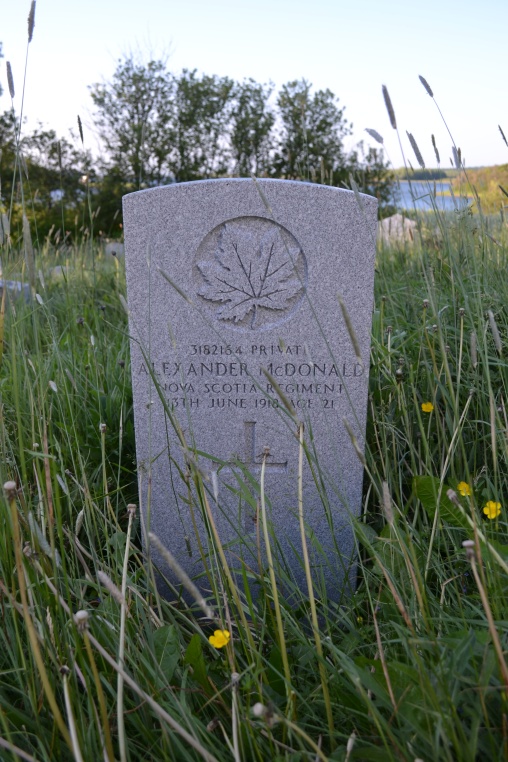
Date of Birth: March 9, 1898 at Upper Big Tracadie, Guysborough County, NS
Parents: Michael & Bridget (Grant) McDonald
Father’s Occupation: Farmer
Family: Brothers John F., William J., Michael, James Vincent, Michael Lawrence and Joseph Leo; sisters Marie A., Ellen and Rose Elizabeth
Marital Status: Single
Occupation: Farmer
Enlistment: April 24, 1918 at Halifax, NS
Unit: 1st Depot Battalion, Nova Scotia Regiment
Service #: 3182164
Rank: Private
Previous Military Service: None
Next of Kin: Bridget McDonald, Upper Big Tracadie, Guysborough County, NS (mother)
Date of Death: June 13, 1918 at Halifax, NS
Final Resting Place: St. Peter’s Church Cemetery, Tracadie, NS
Alexander McDonald was the second youngest of 10 children—seven boys and three girls—born to Michael and Bridget (Grant) McDonald of Upper Big Tracadie, Guysborough County. Michael was the son of Malcolm McDonald, while Bridget was the daughter of John and Bridget Grant. The McDonald and Grant families lived close to one another in the Upper Big Tracadie area.
Michael McDonald passed away on May 1, 1898, leaving his widow, Bridget, to care for a large family. Alexander remained at home, working on the family farm alongside his older siblings until called to service under the terms of the Military Service Act (1917).
Throughout the war’s first three years, military officials relied entirely on voluntary enlistment to provide manpower for the Canadian Expeditionary Force. Recruitment numbers declined significantly by early 1917, at which time Canadian Prime Minister Robert Borden reluctantly agreed to introduce conscription.
In August 1917, the Canadian Parliament approved the Military Service Act, requiring all eligible males ages 18 to 45 to register for military service. The first “conscripts” received orders to report in mid-October, although military training did not commence until January 1918.
In the interim, Borden formed the “Unionist” Party, a coalition of Conservative and Liberal politicians who supported conscription, and dissolved the House of Commons. The Unionists’ subsequent victory in the hotly contested December 1917 federal election provided a mandate to introduce compulsory military service, although the policy was widely unpopular in Quebec and rural parts of Canada.
Not all young Canadian men complied with the Military Service Act’s requirements, a considerable number refusing to register. However, authorities diligently tracked down “defaulters” and ordered them to report for duty. Alexander was one such case finally completing his enlistment papers and medical examination at Halifax on April 24, 1918. He was 21 years old at the time, five feet nine inches in height and 169 pounds in weight.
Health issues soon ended Alexander’s military training. On May 7, he was admitted to Station Hospital, Cogswell St., Halifax, suffering from an “inflammation of [the] accessory sinuses (frontal)” and “photophobia [sensitivity to light].” Medical records describe his condition at the time: “Slight discharge of nose[,] very slight sore throat and aches and pains all over body. Elevated temperature and coated tongue.”
Within 24 hours, Alexander’s throat was “not so sore—light does not hurt eyes. Improved greatly…. Cough easier.” His temperature, however, remained high and doctors described a “tracheal cough [as] very troublesome.” Alexander still complained of a “frontal headache most marked on right side—also of ‘sore eyes’.” A deviated septum prevented medical staff from examining his right sinus, although no pus was detected on the left side.
By May 11, medical records reported considerable improvement: “Temperature now normal. Feels very much improved.” Four days later, however, Alexander was once again in bed, his temperature above 100 degrees Fahrenheit (37.8 degrees Celsius). On May 21, a “chill and sharp rise [in temperature] to 103 degrees [39.4 Celsius]” resulted in his transfer to a surgical ward, where Alexander was diagnosed with pneumonia and empyema, an accumulation of pus in the lung cavity frequently associated with his respiratory ailment.
An examination conducted two days later detected “pneumonia of lower left lobe,” while a subsequent pathology report described Alexander’s pleural fluid as “loaded with streptococci.” As a result, surgeons conducted an “operation for empyema” on May 27, inserting two tubes into the lung cavity and removing “considerable yellowish fluid with masses of lymph.” Following the procedure, Alexander received a dose of “antistreptococcal serum, Hypos Camphor, Strychnia [and] Whiskey.”
Medical notes described an “abundant purulent discharge” seeping from his surgical wound for several days after surgery. Despite continued application of “anti-streptococcal service,” Alexander’s condition deteriorated, a Medical Board document subsequently reporting: “This man died of Pneumonia and Empyema due to Streptococcal infection, on June 13, 1918.” Alexander’s “Case History Sheet” recorded the precise time of death as “2.10 p.m.”
Alexander’s remains were transported home for interment in St. Peter’s Church Cemetery, Tracadie, NS. Several years after the war, his mother, Bridget, received a Memorial Plaque and Scroll and Memorial Cross bearing her youngest son’s name.